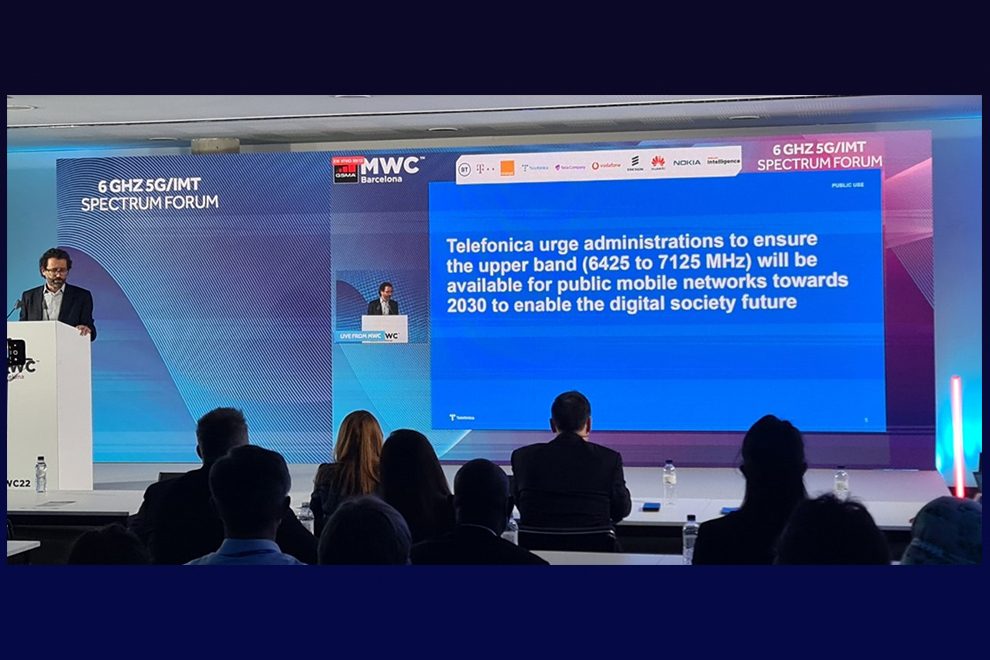During Mobile World Congress in Barcelona, six global operators including BT, Vodafone, Deutsche Telekom, Orange, Telefonica, and Telia Company, together with leading global suppliers including Ericsson, Huawei, Nokia, and GSMA Intelligence, jointly hosted 6 GHz 5G/IMT Spectrum Forum to discuss the future use of the 6 GHz band.
The meeting called for the industry to recognize the importance of 6 GHz as 5G/IMT Spectrum to the mobile industry, promote the use of 6 GHz as WRC-23 approaches, expand the 5G and mobile industry space, and facilitate global digitalization. Key contributions were made from important policymakers and regulatory bodies from Finland, France, Kenya, Tunisia, and the UAE.
During the meeting, the GSMA highlighted the special role of mid-bands for 5G estimating a contribution of USD610bn by 2030 in terms of socio-economic benefits. Moreover, GSMAi shared the key points from its latest report, The Socioeconomic Value of the 6 GHz Band, noting: “All 6 GHz band assigned to licensed use will deliver the largest benefits across all countries if fixed broadband technologies do not provide maximum available speeds above 5Gbps, 700MHz assigned to licensed use will deliver the largest benefits if FTTH/B and cable broadband adoption is widespread, all 6 GHz band assigned to unlicensed use was not found to be the most beneficial allocation in any of the considered analyses.”
Tariq Al Awadhi, Chairman, Arab Spectrum Management Group (ASMG) & the Executive Director Spectrum Affairs in the Telecommunication Regulatory Authority acknowledged the rapid development of 5G and the GSMA conclusions that there will be need for 2GHz of mid-band spectrum between 2025-2030, ASMG will continue working to ensure the most balanced position for 6 GHz band and continue working on WRC23 AI1.2 in its WG1.
Roberto Rodriguez, Head of Spectrum Strategy from Telefonica said, 6 GHz spectrum is the only foreseeable opportunity to ensure the continued support of 5G services quality in the mid-term and urged administrations to ensure the upper band (6425 to 7125 MHz) is available for public mobile networks towards 2030 to enable the digital society future.
Santiago Tenorio from Vodafone recalled Vodafone’s fixed and mobile operations in 21 countries as a convergent operator with the biggest footprint in NGN broadband access. He said that it is super important to keep a balanced approach in the 6 GHz band. “We are seeing significant growth in traffic rate, nearly doubling every year. That growth can be accelerated by other applications such as AR/VR and metaverse. We think the 3.5 GHz will be congested before the end of the decade. If we let 5G exhaust its capacity that will slow down digitalization of society and that will be a terrible mistake that would only push this region backward increasing the gap with the economy of other regions.”
A spokesman for Nokia mentioned that 6 GHz is a key resource for 5G and future evolution to 5G-Advanced. From the vendor’s view, 6 GHz can Re-use existing C-Band macro-cell grid to provide high capacity citywide as well as urban and suburban coverage. Currently, the global spectrum demand and consensus on 6 GHz has been formed, and WRC-23 will be the key path to promote this consensus. 3GPP is expected to complete the standardization of U6G by June 2022, and Nokia will work with the industry to continuously promote 6 GHz products and industry progress.
Wireless Network Chief Strategy Officer, Huawei, explained that the 6 GHz particularly focuses on outdoor, and 5G is key for digital transformation. New services like metaverse will need to be available both outdoor and indoors. Mid-bands especially 6 GHz bring value to our customers with high performance lower cost and less power consumption. Looking at the future whether we can identify more mid-bands in Europe, China and other regions are essential. The base station may have the same coverage at 6 GHz with 128 TRX Massive MIMO to 3.5GHz with 64 TRX and with an additional 15% of throughput gain. 6 GHz is very essential to provide outdoor coverage in the “metaverse era” in the future for beyond 5G and the mobile industry.
Erika Tejedor, Director of Government and Industry Relations at Ericsson, elaborated on the IMT ability to share spectrum with services that are in the 6 GHz band including satellite uplink, downlink and fixed links, as well as Earth Exploration Satellite Service (EESS) and Radio astronomy.” We need to keep discussing more in detail all studies submitted to ITU, but indeed we see that sharing and compatibility is possible in the band assuming citywide deployments”.












